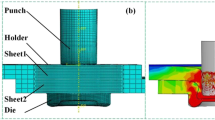Abstract
In hobbing motion chamfering of cylindrical gear tooth profiles, the tool parameters and mounting position parameters of the chamfering tool directly affect the results. In this paper, the co-optimization method of multiparameters is proposed. Considering the consistency and symmetry of the chamfering result, a multiparameter co-optimization model is established. The improved non-dominated sorting genetic algorithms-II (INSGA-II) is proposed for the optimization effect of the model. The optimization and determination parameter combinations are performed using INSGA-II and Fuzzy C-means_Grey Relational Projection (FCM_GRP). Finally, the optimized parameter combinations are used to calculate the tool rake face profile, and the local curve superposition improves the uneven chamfering at the transition arc. The proposed method’s effectiveness is verified based on the tooth profile chamfering simulation results.














Similar content being viewed by others
Data availability
The datasets used or analyzed during the current study are available from the corresponding author on reasonable request.
References
Zhao H, Wu Q, Huang K, Qiu M, Liu P (2013) Status and problem research on gear study. J Mech Eng 049:11–20
Ding S, Zhang H, Guo E, Wu W, Zhang Y, Song A (2021) Integrated roughing, finishing and chamfering turning process of toroidal worm manufacture on a general CNC lathe. J Manuf Process 70:341–349
Hu J, Pagilla PR (2021) Dual-edge robotic gear chamfering with registration error compensation. Robot Comput Integr Manuf 69:10208
Schlatter M, Müller N (2019) A New Method for Gear Chamfering. In: Hloch S, Klichová D, Krolczyk GM et al (eds) Advances in Manufacturing Engineering and Materials. Springer International Publishing, Cham, pp 18–26
Wei W, Li Z, Tan R (2021) Tooth crest chamfering method of spiral bevel gear using ball end milling cutter. Proc Ins Mech Eng 235:726–740
Tatar K, Svenningsson I (2022) Effect of chamfer width and chamfer angle on tool wear in slot milling. Int J Adv Manuf Technol 120:2923–2935
Wang N, Tang Y, Wang P (2011) The design and simulation of gear-shaped profile chamfering structure. AMR 305:300–305
Ventura CEH, Köhler J, Denkena B (2014) Strategies for grinding of chamfers in cutting inserts. Precis Eng 38:749–758
Asad M, Ijaz H, Khan MAA, Khan M, Mabrouki T, Rashid MU (2022) Comparative analyses and investigations of chamfered and honed-edge tool geometries on tool wear, chip morphology, residual stresses and end-burr formation. J Manuf Process 80:196–209
Fang N, Wu Q (2005) The effects of chamfered and honed tool edge geometry in machining of three aluminum alloys. Int J Mach Tools Manuf 45:1178–1187
Huang N, Krebs E, Baumann J, Zhou Y, Wu S, Biermann D (2020) Experimental investigation on influence of engagement angle and tool geometry on plunge milling. Int J Adv Manuf Technol 108:1973–1981
Ahmed F, Ko TJ, Jongmin L, Kwak Y, Yoon I, Kumaran S (2021) Tool geometry optimization of a ball end mill based on finite element simulation of machining the tool steel-AISI H13 using grey relational method. Int J Precis Eng Manuf 22:1191–1203
Duan X, Peng F, Zhu K, Jiang G (2019) Tool orientation optimization considering cutter deflection error caused by cutting force for multi-axis sculptured surface milling. Int J Adv Manuf Technol 103:1925–1934
Li Y, Wang J, Zhao D, Li G, Chen C (2018) A two-stage approach for combined heat and power economic emission dispatch: combining multi-objective optimization with integrated decision making. Energy 162:237–254
Cao Y, Dhahad HA, Mohamed AM, Anqi AE (2021) Thermo-economic investigation and multi-objective optimization of a novel enhanced heat pump system with zeotropic mixture using NSGA-II. Appl Therm Eng 194:116374
Yuan M, Li Y, Zhang L, Pei F (2021) Research on intelligent workshop resource scheduling method based on improved NSGA-II algorithm. Robotics and Computer-Integrated Manufacturing 71:102141
Zhang M, Luo W, Wang X (2009) A normal distribution crossover for e-MOEA. Journal of Software 20:305–314
Xia T, Li M (2021) An efficient multi-objective robust optimization method by sequentially searching from nominal Pareto solutions. J Comput Inf Sci Eng 21:041010
Zhou S, Li D, Zhang Z, Ping R (2021) A New Membership Scaling Fuzzy C-Means Clustering Algorithm. IEEE Trans Fuzzy Syst 29:2810–2818
Hao X, Li M, Chen Y (2020) China’s overcapacity industry evaluation based on TOPSIS grey relational projection method with mixed attributes. GS 11:288–308
Sun G, Guan X, Yi X, Zhou Z (2018) Grey relational analysis between hesitant fuzzy sets with applications to pattern recognition. Expert Syst Appl 92:521–532
Zhang Z, Chen L (2018) Analysis on decision-making model of plan evaluation based on grey relation projection and combination weight algorithm. J Syst Eng Electron 29:789–796
Funding
We gratefully acknowledge the financial support of the Key Projects of Strategic Scientific and Technological Innovation Cooperation of the National Key R&D Program of China (No. 2020YFE0201000), the China Postdoctoral Science Foundation (No. 2021M700618), Special Funding for Postdoctoral Research Projects in Chongqing, the National Natural Science Foundation of China (No. 51905059), and the Innovative Research Group of Universities in Chongqing (No. CXQT21024).
Author information
Authors and Affiliations
Contributions
Kun He contributed to the conception of the study; Xiaohu He performed the experiment; Xiaohu He contributed significantly to the analysis and manuscript preparation; Yanbin Du, Aoting Wang, and Xiao Yang helped perform the analysis with constructive discussions.
Corresponding author
Ethics declarations
Ethics approval
Not applicable.
Consent to participate
Not applicable.
Consent for publication
Yes.
Competing interests
The authors declare no competing interests.
Additional information
Publisher's Note
Springer Nature remains neutral with regard to jurisdictional claims in published maps and institutional affiliations.
Rights and permissions
About this article
Cite this article
He, K., He, X., Du, Y. et al. The co-optimization method of tool parameters and mounting position parameters for cylindrical gear chamfering tool. Int J Adv Manuf Technol 121, 4473–4483 (2022). https://doi.org/10.1007/s00170-022-09616-z
Received:
Accepted:
Published:
Issue Date:
DOI: https://doi.org/10.1007/s00170-022-09616-z




